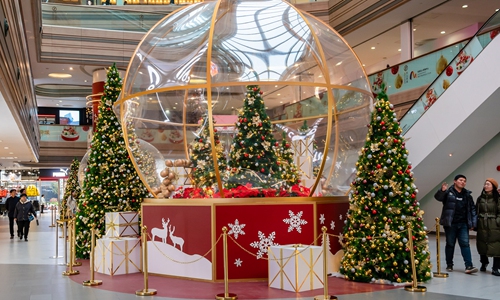HOME >> SOURCE
American Dream to focus on entertainment, bypassing US mall nightmare
Source:Global Times Published: 2019/12/3 20:53:41

Christmas decorations appear at a shopping mall in Shanghai on Monday. As Christmas approaches, Chinese shopping malls are putting up Christmas trees and other decorations to attract customers and harvest a satisfactory year-end sales performance. Photo: VCG
New Jersey is doubling down on the mall. The Garden State is home to one of the largest shopping complexes to open in recent memory. American Dream, as it's called, offers a dizzying array of theme parks better suited to Dubai. The hope is that this will help push people through the door. With retail sales swiftly moving online, that may not be enough.The mega-mall was a long time in the making. Originally conceived as "Xanadu" 15 years ago, it has endured bankruptcy, multiple backers including US Treasury Secretary Steven Mnuchin and Colony Capital's Tom Barrack, and a price tag of about $5 billion. Triple Five, the developer of West Edmonton Mall in Canada and Mall of America, bought it in 2011 and is betting over-the-top experiences will decrease its exposure to retail.
To do that, Triple Five set aside 55 percent of the American Dream's 3 million square feet for theme parks including a SpongeBob roller coaster, a ski slope, an ice rink and water slides. Other amenities range from nannies for parents who want to shop in peace to helipads for passengers who can afford to avoid the often-clogged Route 3 highway. The goal is to attract a projected 40 million people annually to the Meadowlands complex.
The retail stores like Tiffany and Saks Fifth Avenue occupying the other 45 percent of the space aren't expected to open until March, however, which means they'll miss the all-important holiday season. That's poor timing for an industry on a roller coaster ride. Tiffany is being gobbled up by LVMH for $16.2 billion. Hudson's Bay, the owner of Saks, is under attack by activists. Barneys New York, which had been touted as an anchor tenant, went belly up in November and was sold for peanuts.
Meanwhile, more people are shopping online. Morgan Stanley reckons retail-store traffic for the first three weeks of November fell nearly 30 percent compared to last year. That's skewed due to the Thanksgiving holiday and Black Friday falling in the third full week of November in 2018 rather than the fourth this year. The last time that shift happened, between 2012 and 2013, the decline was just 15 percent.
E-commerce sales are likely to outpace the growth rate of brick-and-mortar sales during holidays, estimates software-and-analytics firm Adobe. The trend suggests malls are more of a nightmare than a dream.
The author is Jennifer Saba, Reuters Breakingviews columnist. The article was first published on Reuters Breakingviews. bizopinion@globaltimes.com.cn
Posted in: INSIDER'S EYE